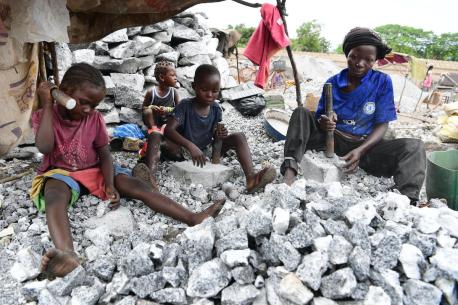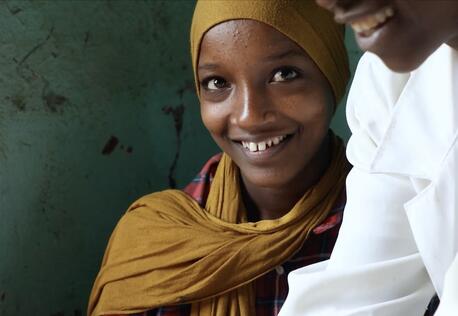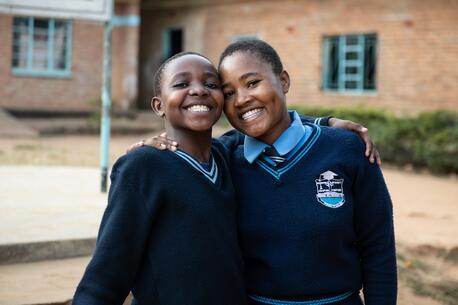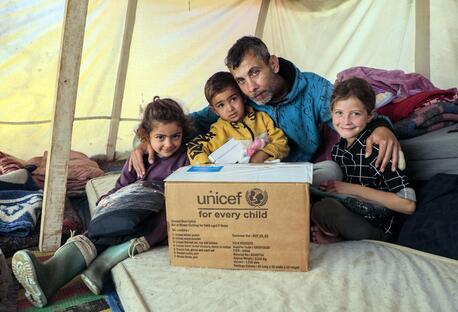
COVID-19 and Child Labor: A Time of Crisis, a Time to Act
With schools closed and extreme poverty on the rise, the coronavirus pandemic threatens to undo decades of progress against one of the most egregious violations of children's rights.
The past two decades have seen significant strides in the fight against child labor. There are an estimated 94 million fewer child laborers today as there were 20 years ago.
Still, the practice has persisted. Nearly half of today's roughly 152 million child laborers are working in jobs deemed hazardous to their health and mental well-being, in agriculture, mining, construction, manufacturing and other sectors.
And now the COVID-19 pandemic threatens to push millions more youth into the workforce as job losses and sharp declines in household income are hitting already vulnerable families hard — putting pressure on kids to contribute.

Miajul, 12, sorts through plastic waste at a dump in Shyamol Palli, Dhaka, Bangladesh, looking for material he can sell to recyclers. © UNICEF/UNI335716
This is especially true for children in low- and middle-income countries whose schools remain closed to contain the spread of coronavirus and for whom remote learning is impossible. Putting out-of-school children to work becomes a survival tactic. Fighting coronavirus is not just about stopping the spread of the deadly virus. The fight against coronavirus has become intertwined with saving children from forced labor that could eclipse their childhood along with their right to a productive, fulfilling future.
Grinding rocks, clearing brush, picking through trash
In India, tens of thousands of children have gone to work in farm fields and in factories, the Associated Press reported. In Kenya, instead of going to school, children are grinding rocks in quarries. Across Latin America, after-school job like making bricks, building furniture or clearing brush are now full-time work. The AP's report highlights these and other examples of kids working in Bolivia, Mexico and Paraguay.
A separate investigation by The New York Times documents the experiences of children in India and Indonesia and elsewhere, including youngsters who spend their days picking through trash to find bits of plastic they can sell to recyclers.

To help support his family, Mohammed, 14, a Syrian refugee from Kobani, works full-time at a car repair shop in Erbil in the Kurdistan region of Iraq. "What I would most like is to leave this job and go back to school," he says. "I miss my school in Syria. I miss my pens and books and I'd like to have them back." Conflict, climate change and now COVID-19 are the major drivers of child labor. © UNICEF/UN020145/Yar
Global economic forecasts are dire. The World Bank projects that global extreme poverty could rise this year for the first time in over 20 years due to economic disruptions from the pandemic, compounded by conflict and climate change. The total number of people living in extreme poverty could jump by as many as 150 million by 2021. Eight out of 10 "new poor" live in middle-income countries, primarily Nigeria and India.
In a joint report entitled, COVID-19 and child labor: A time of crisis, a time to act, UNICEF and the International Labor Organization (ILO) examine the effects of these trends and other factors on children and what governments, working with labor groups, the private sector and other partners can do about it.

La La, 10, left, and Noor Bi, 8, sell fish at a market in the Sin Tet Maw camp for families displaced by violence in Rakhine State, Myanmar. It's unclear how many students have dropped out of their school systems, but pandemic-related school closures have affected some 1.6 billion children globally, and, according to UNICEF's estimates, at least 463 million kids remain cut off from education. © UNICEF/UN061817/Brown
To help vulnerable families avoid resorting to child labor, the report urges governments to find ways to strengthen or expand social protection measures that ensure access to health care and support job, income and food security.
Cash transfers have previously been shown to help deter or reduce child labor by helping households cope with economic shocks. (UNICEF is a proponent.) Improving access to credit, allowing for the restructuring of personal debt (or suspending repayments) and offering tax exemptions and unemployment benefits can also be effective. A variety of these measures are already being tried in many countries, the report notes.
The complexity of the issue and the unique nature of the COVID-19 crisis make it clear there is no single solution, which is why the report offers several different possible ways forward. (Read the full report.)
"Global progress on child labor has come from improving living standards, expanding social protection and support, and paying greater attention to adolescent welfare," the report reads. "All of these gains are under threat. Finding alternative, inexpensive ways to reinforce the advances made will be a priority in the coming years."
Child labor deprives children of their childhood and their future
UNICEF's stance on child labor is clear. Child labor deprives children of their childhood and their future. Unlike activities that help a child to develop, such as contributing to housework for a few hours a week or taking on a job during school holidays, child labor interferes with schooling and is harmful to a child’s physical, mental, social and/or moral development. It is both a cause and a consequence of poverty, reinforcing social inequality and discrimination.

Amira works long hours as a seasonal agricultural worker in Turkey. © UNICEF/UN064360/Feyizoglu
Child labor is a flagrant violation of child rights as stipulated under Article 32 of the Convention on the Rights of the Child, which recognizes the right of every child to be protected from economic exploitation and from performing any work that is likely to interfere with the child’s education or harm the child’s health. In its worst forms, child labor can result in slavery, sexual exploitation and death.
The biggest risk factor: being out of school
The biggest risk factor for kids is being out of school. The gradual reopening of schools will be a critical window to help children restart their education and avoid permanently dropping out. Community-level action will be needed to ensure that every child returns to school when it is safe to do so. And cash transfers and other social protection benefits can compensate vulnerable famiies for children's lost earnings, the UNICEF/ILO report notes.
"For the most marginalized, missing out on school ... can lead to negative outcomes that last a lifetime," UNICEF Executive Director Henrietta Fore said during a recent press briefing. "We know that beyond learning, schools provide children with vital health, immunization and nutrition services, and a safe and supportive environment ... We also know that the longer children remain out of school, the less likely they are to return."
UNICEF works closely with national and local governments to support development and implementation of comprehensive strategies to address child labor. Learn more about how UNICEF works with partners to strengthen social protections, improve education and alleviate the effects of poverty to help end child labor around the world.
Top photo: Children work at a granite mine in Pissy, a suburb of Ouagadougou, the capital of Burkina Faso. The age range of child laborers in the country is 5 to 17, but it is also common to find babies and toddlers on site next to their working mothers. © UNICEF/UNI394747/Dejongh
HOW TO HELP
There are many ways to make a difference
War, famine, poverty, natural disasters — threats to the world's children keep coming. But UNICEF won't stop working to keep children healthy and safe.
UNICEF works in over 190 countries and territories — more places than any other children's organization. UNICEF has the world's largest humanitarian warehouse and, when disaster strikes, can get supplies almost anywhere within 72 hours. Constantly innovating, always advocating for a better world for children, UNICEF works to ensure that every child can grow up healthy, educated, protected and respected.
Would you like to help give all children the opportunity to reach their full potential? There are many ways to get involved.





